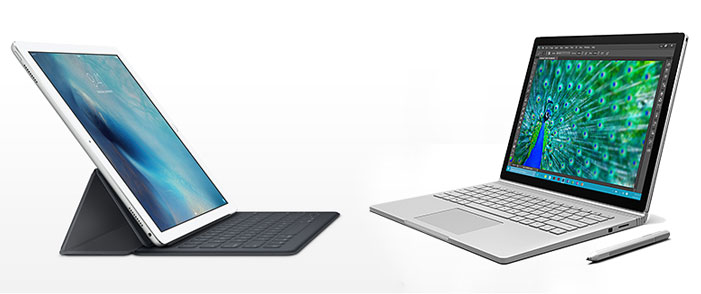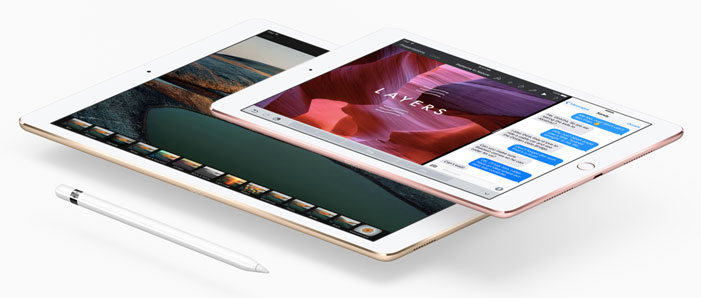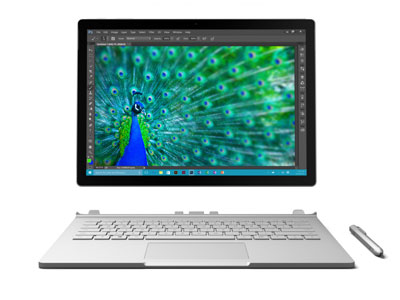The writing is on the wall. Moore’s law. Everything tech gets better and faster. Desktops become a thing of the past as notebooks and tablets offer incomparable convenience and ease of use. Now Apple declares the end of the PC, with the iPad Pro being a replacement for a notebook or desktop for many people. When Tim Cook announced the A4-sized iPad, he said it could do as much as 80 to 90 percent of what anyone could do on a traditional laptop. That might be 80 to 90 percent true. In the case of Apple, hardware mobile devices develop faster than 3rd party software. Nevertheless, is it time to switch?
Not to mince one’s words, and I’m no Apple fanboy, even though everything around here is Apple, but for reasons only known to Cupertino the iPad Pro in fact is an oversized iPhone, not offering the functionality and flexibility needed. We’re waiting in vain for OS X in an Apple tablet — something Microsoft does right. Their Surface Pro and Surface Book lineup — Amazon and eBay — features full Windows 10 OS. And not Windows Mobile.

With OS X under the hood the iPad Pro would be a no-brainer. Meaning, many people who don’t need their hardware for just email correspondence, Web browsing and snaps are now using at least three devices each, two of which are desktops or laptops, one at work and one at home. The third device is a smartphone. Cut that all down to one, that’s the aim.
The iPad Pros — now with a 12.9-inch and a 9.7-inch model available on Amazon and eBay — are the most capable tablets Apple have ever produced, as a well as a massive canvas for creative types. But let’s not kid around here — they’re not even in the same category as Microsoft’s Surface models. Whether you gel with Microsoft’s 2-in-1 vision for Windows 10 or not (or Lenovo’s Yoga lineup for that), there’s no denying that they offer a much more capable and flexible solution than the iPad Pros.

Microsoft is making a big deal about going after Apple. Surface sales still pale in comparison to iPads, but Microsoft seems to be envisioning a future where their hybrids are a real alternative to the market leader. Specs are only half of the story, yet Microsoft’s Surface tablets are a full power laptop with detachable screen. So, are the iPad Pros competing with the Surfaces? Again, iPads don’t run a traditional desktop OS. Surface is rather competing with the MacBooks.

From a photographer’s point of view, a Surface is something that you might consider replacing your laptop or even desktop computer with, under certain circumstances. The iPad Pro is something you might consider replacing your aging iPad with.
Both are great devices, and Apple’s peerless app ecosystem and cross-device hardware integration continue to impress. But Apple made the wrong decision here. The iPad Pro is a tablet. It doesn’t quite match up to those laptop-replacement marketing pitches. A fully functional OS simply offers the more capable, flexible and downright useful device. And to be honest, the UI neither looks rewarding nor entertaining designed for much smaller phone devices. A lot of potential wasted.
As with many things about the iPad Pro, the superior hardware is waiting for the software to catch up. Additionally, am not a RAW shooter myself, but the lack of RAW support in iOS hinders pro and enthusiast photographers from developing workflows that avoid duplicating work or depending on a Mac to get started.
On the other hand, be open to new workflows and reinvigorate a dusty mindset!
In terms of photo editing, everything is available on the Surface, and bit by bit iPad Pro apps are catching up. In fact, just think outside the box. Plenty of apps let you edit photos, such as standouts like Google’s Snapseed, Adobe’s Lightroom Mobile, VSCO and of course Apple’s own Photos app.
Support for the Apple Pencil, though, adds another level of editing. Adobe’s Photoshop Fix senses pressure and angle using the Pencil for precise adjustments. For example, when you need to lighten just one area of a person’s face, or discreetly erase some age wrinkles, you don’t need to wait until you’re back on your Mac.
Lightroom and Photoshop Fix can run side-by-side, and they can both access the same libraries via Creative Cloud Sync, enabling you to send an image from Lightroom to Fix to perform some spot healing, a feature missing in Lightroom.
And that RAW deal? iPads still don’t offer system-level support for RAW formatted images. If your don’t shoot RAW, this won’t hold you back. RAW files transfer to the iPad, but any edits made are applied to the thumbnail preview the camera creates to display on its LCD. So, when you edit on the iPad, you’re not taking full advantage of the editing possibilities RAW formats offer.
Overall, as a photographer trying to migrate to the iPad Pro, you’re basically covered with the two free apps Snapseed and Lightroom Mobile plus Pixelmator ($4.99) which fully supports Apple Pencil.
Again, using the iPad Pro as a photographer’s tool is more about attitude and approach, and less about hardware and software capabilities. You will be able to find your ways — and develop new ways, with the likelihood of making traditional ways redundant over time.
No, the iPad Pro is no toy. Yes, it is an oversized iPhone. And that’s a great device, a device one can adapt to. So down the road, there may be no need for OS X.
iPad Pro is available on Amazon and eBay, Surface Book on Amazon and eBay.


